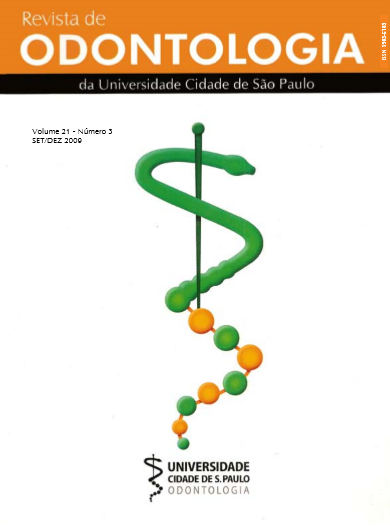Epidemiological investigation of second premolar agenesis and its relationship with agenesis of other permanent teeth
DOI:
https://doi.org/10.26843/ro_unicid.v21i3.461Palavras-chave:
Anodontia, Tooth abnormalities, Genetics.Resumo
ObjectiveDownloads
Referências
Alexander-Abt J. Apparent hypodontia: A case of misdiagnosis. Am J Orthod Dentofacial Orthop. 1999;116:321-3.
Bredy E, Erbring C, Hubenthal B. The incidence of hypodontia with the presence and absence of wisdom teeth. Dtsch Zahn Mund Kieferheilkd Zentralbl. 1991;79:357-63
Brook AH. A unifying aetiological explanation for anomalies of human tooth number and size. Arch Oral Biol. 1984;29:373-8. 4. Castilho JCM, Nicodemo RA, Bazzarella CB, Moraes LC. Prevalência de anodontia entre estudantes do 2º grau da cidade de São José dos Campos ? correlação dessa anomalia entre terceiros molares e outros órgãos dentários. Rev Odont UNESP. 1990;19:269- 276.
Coupland MA. Apparent hypodontia. Br Dent J. 1982;152:388.
Endo T, Ozoe R, Kubota M, Akiyama M, Shimooka S. A survey of hypodontia in japonese orthodontics patients. Am J Orthod Dentofacial Orthop. 2006;129:29-35.
Garn SM, Lewis AB, Vicinus JH. Third molar polymorphism and its significance to dental genetics. J Dent Res. 1963;42:1344-63.
Garn SM, Lewis AB. The relationship between third molar agenesis and reduction in tooth number. Angle Orthod. 1962;32:14-18.
Grieco FAD, Carvalho PEG, Guedes ? Pinto E, Garib DG, Valle ? Corotti KM. Prevalência de agenesia dentária em pacientes ortodônticos da cidade de São Paulo. RPG Rev Pós Grad. 2007;13:312 -7.
Kirzioglu Z, Sentut TK, Erturk MSO, Karayilmaz H. Clinical features of hypodontia and associated dental anomalies: a retrospective study. Oral Dis. 2005;11:399-409.
Kotsomitis N, Freer TJ. Inherited dental anomalies and abnormalities. J Dent Child. 1997;64:405-8.
Lynham A. Panoramic radiographic survey of hypodontia in Australian Defense Force recruits. Aust Dent J. 1990;35:19-22.
Meza RS. Radiographic assessment of congenitally missing teeth in orthodontic patients. Int J Paediatr Dent. 2003;13:112-6.
Moorrees CF, Fanning EA, Hunt EE, Jr. Age Variation of Formation Stages for Ten Permanent Teeth. J Dent Res. 1963;42:1490-502.
Peck L, Peck S, Attia Y. Maxillary canine-first premolar transposition, associated dental anomalies and genetic basis. Angle Orthod. 1993;63:99-109.
Polder BJ, Van? t Hof MA, Van der Linden FPGM, Kuijpers-Jagtman AM. A meta-analysis of the prevalence of dental agenesis of permanent teeth. Community Dent Oral Epidemiol. 2004;32:217-26.
Ravn JJ, Nielsen HG. A longitudinal radiographic study of the mineralization of 2nd premolars. Scand J Dent Res. 1977;85:232-6.
Rolling S. Hypodontia of permanent teeth in Danish schoolchildren. Scand J Dent Res. 1980;88:365-9.
Rose JS. A survey of congenitally missing teeth, excluding third molars, in 6000 orthodontic patients. Dent Pract Dent Rec. 1966;17:107-13.
Silva AC, Luca DN, Lacerda M. Anodontia parcial congênita: estudo da prevalência em dentes permanentes. Rev Odontol UNICID. 2004;16:41-5.
Stritzel F, Symons AL, Gage JP. Agenesis of second premolar in males and females: distribution, number and sites affected. J Clin Pediatr Dent. 1990;15:3041.
Svedmyr B. Genealogy and consequences of congenitally missing second premolars. J Int Ass Dent Child.1983;14:77-82.
Tristão MC, Gomes AMM, Valle MAS, Gomes AA. Avaliação radiográfica da ocorrência de agenesia de dentes permanentes. Rev Assoc Paul Cir Dent. 2003;57:337-410

